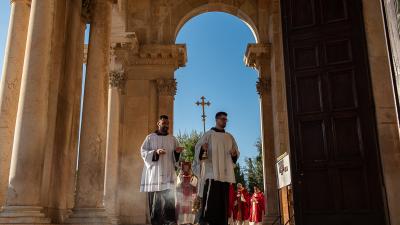
“Vexilla regis prodeunt, fulget crucis mysterium.” This is what Venanzio Fortunato wrote in his famous hymn to the Cross 1500 years ago and this it is still repeated today: “The king's banner is advancing; the mystery of the cross is resplendent.” The Custos of the Holy Land carried the reliquary in procession, while songs from the [more than] thousand-year history accompanied the solemn celebration. At Holy Sepulcher, May 7 is when the Feast of the Cross, one of the most important for the Basilica of the Resurrection, takes place. At the origin of solemnity and recognition of the place where Christ died and rose is the episode of the discovery of the relic of the Cross by Helena, the mother of Emperor Constantine. Several sources tell us what was likely happened in 325 A.D.: “As soon as that very religious woman hurried to go to this place, [...] she found three crosses placed in a random order,” one can read in the readings on the eve of the feast. According to the story of the Church of Saint Rufino, Helena discovered which one was Christ's Cross among those that she had found, because with it cured a dying woman.
This episode has been remembered for almost 1700 years, in the grotto of Saint Helena, which is decorated in gold and red. Carried in the procession during vespers, the vigil and the Sunday mass, the relic represents the sacrifice of Christ, who was crucified and died for the salvation of the world, for [all of] humanity.
The Custos of the Holy Land in his homily recalled that death by crucifixion was reserved for those whose dignnity was not recognized. “Jesus' crucifixion is a gesture of [his] total sharing in [our] humanity,” he continued. “He puts himself in the place of the criminal, the slave, the damned, and shows us that no one is without dignity.” On the cross, Jesus therefore manifested a love that is stronger than death and was able to heal the world. How do we live out this feast in an existential manner? “We become a living image of Christ on the Cross,” said Fr. Francesco Patton, “in order to share in our resurrection as well.”
“If you think about the Cross, you expect something sad, and yet today the paschal mystery is made present,” said Sarah, a pilgrim from Rome who was present at the solemnity. Just like at the Holy Sepulcher there is both Calvary and the Empty Tomb, today we also celebrated the Cross during Easter time and during the whole celebration, we sang about the resurrection. The Invention of the Cross is a well attended feast in Jerusalem, but outside [of this place] it is no longer included in liturgical celebrations; the solemnity of the Exaltation of the Cross on September 14 is still celebrated, despite that it is not as ancient [of a feast]. “We came here today almost by accident, but we celebrated this feast with joy for the first time,” said a man from Jerusalem named Maazen.
The Franciscan friars of the Custody of the Holy Land, on the occasion of solemnity, began their procession from Saint Savior's Monastery, preceded by the Kawas, who then animated the celebrations of the vespers, the vigil and the mass at the Holy Sepulcher. Faithful from all over the world sang hymns to the Cross. After the mass, during the traditional three circles made by the procession around the Edicule, two little girls dressed in white cast flower petals before the passage of the Holy Reliquary. Inside the walls of the Holy Sepulcher, the Vexilla Regis could still be heard today, so as to recognize Christ's Cross,” the only hope, the source of salvation.”
Beatrice Guarrera




